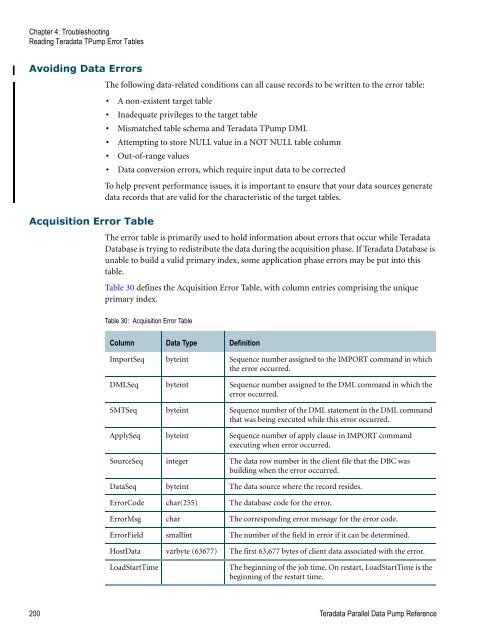Teradata Parallel Data Pump
Teradata Parallel Data Pump Reference - Teradata Developer ...
Teradata Parallel Data Pump Reference - Teradata Developer ...
- No tags were found...
You also want an ePaper? Increase the reach of your titles
YUMPU automatically turns print PDFs into web optimized ePapers that Google loves.
Chapter 4: Troubleshooting<br />
Reading <strong>Teradata</strong> T<strong>Pump</strong> Error Tables<br />
Avoiding <strong>Data</strong> Errors<br />
Acquisition Error Table<br />
The following data-related conditions can all cause records to be written to the error table:<br />
• A non-existent target table<br />
• Inadequate privileges to the target table<br />
• Mismatched table schema and <strong>Teradata</strong> T<strong>Pump</strong> DML<br />
• Attempting to store NULL value in a NOT NULL table column<br />
• Out-of-range values<br />
• <strong>Data</strong> conversion errors, which require input data to be corrected<br />
To help prevent performance issues, it is important to ensure that your data sources generate<br />
data records that are valid for the characteristic of the target tables.<br />
The error table is primarily used to hold information about errors that occur while <strong>Teradata</strong><br />
<strong>Data</strong>base is trying to redistribute the data during the acquisition phase. If <strong>Teradata</strong> <strong>Data</strong>base is<br />
unable to build a valid primary index, some application phase errors may be put into this<br />
table.<br />
Table 30 defines the Acquisition Error Table, with column entries comprising the unique<br />
primary index.<br />
Table 30: Acquisition Error Table<br />
Column <strong>Data</strong> Type Definition<br />
ImportSeq byteint Sequence number assigned to the IMPORT command in which<br />
the error occurred.<br />
DMLSeq byteint Sequence number assigned to the DML command in which the<br />
error occurred.<br />
SMTSeq byteint Sequence number of the DML statement in the DML command<br />
that was being executed while this error occurred.<br />
ApplySeq byteint Sequence number of apply clause in IMPORT command<br />
executing when error occurred.<br />
SourceSeq integer The data row number in the client file that the DBC was<br />
building when the error occurred.<br />
<strong>Data</strong>Seq byteint The data source where the record resides.<br />
ErrorCode char(255) The database code for the error.<br />
ErrorMsg char The corresponding error message for the error code.<br />
ErrorField smallint The number of the field in error if it can be determined.<br />
Host<strong>Data</strong> varbyte (63677) The first 63,677 bytes of client data associated with the error.<br />
LoadStartTime<br />
The beginning of the job time. On restart, LoadStartTime is the<br />
beginning of the restart time.<br />
200 <strong>Teradata</strong> <strong>Parallel</strong> <strong>Data</strong> <strong>Pump</strong> Reference









